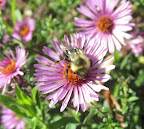Invertebrate diversity tally
By Peggy Ashbrook
Posted on 2012-10-16
Students at Bailey’s Elementary School for the Arts and Sciences are finding out how many different kinds of invertebrates live in their schoolyard. Using a poster showing the invertebrates that are common in a Northern Virginia pollinator garden to familiarize themselves with these small animals, second-graders went out into the garden to see what they could find. They also used the poster to collect data. Every time they saw an animal such as a roly-poly or Monarch butterfly caterpillar, they put a tally mark on the laminated poster using a dry erase marker. The purpose of this activity was to notice how many kinds of invertebrates there are in a small garden, a diversity of life.
 Most of the classes found about 25 different species during their 15 minute search. Students may come up with questions while searching. Teachers can record the students’ questions and later talk about how the class might find answers to the questions. Are any of the questions investigable, that is, can the students investigate to find answers or is that beyond their capabilities or the scope of a school year? Some questions can be researched in books, online, or by asking experts. Others can be answered with student data collection, analysis and discussion. One such question might be, “Will we always find roly-polies under the log?” How many days would your students have to collect data to feel that they had answered this question?
Most of the classes found about 25 different species during their 15 minute search. Students may come up with questions while searching. Teachers can record the students’ questions and later talk about how the class might find answers to the questions. Are any of the questions investigable, that is, can the students investigate to find answers or is that beyond their capabilities or the scope of a school year? Some questions can be researched in books, online, or by asking experts. Others can be answered with student data collection, analysis and discussion. One such question might be, “Will we always find roly-polies under the log?” How many days would your students have to collect data to feel that they had answered this question?
Editor Linda Froschauer wrote in her column in the December 2010 Science & Children, “Students have many questions, but in an inquiry setting they need to be taught how to formulate questions that will provide them with opportunities to investigate and ultimately develop understanding.” She says that students need ample time to explore a phenomenon before they can design questions that they can investigate.
To ask questions and share your experience with science inquiry, join the conversation in The NSTA Learning Center’s Elementary Science Forum, “Helping Elementary Teachers Embrace Inquiry.” Register at no cost to read and participate.
Disclaimer: The views expressed in this blog post are those of the author(s) and do not necessarily reflect the official position of the National Science Teaching Association (NSTA).


